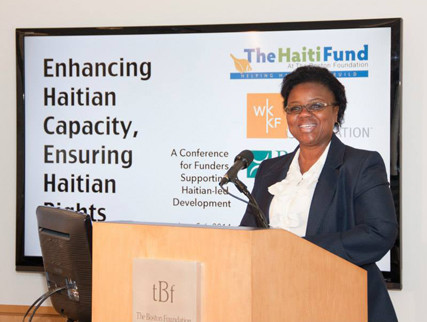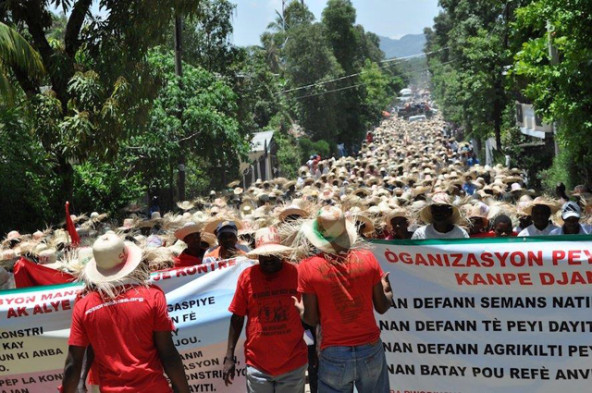With questions surfacing in the media about the Red Cross' housing program and Sean Penn rising to the organization’s defense, the debate about how best to help Haiti is in full swing. And this is before the press on Hillary Clinton's campaign scrutinizes her foundation's multi-million dollar investments in Haiti's recovery from the 2010 earthquake.
The Haiti Fund of the Boston Foundation was born the day after that quake, a time of great torment but potential promise as well. Without careful rethinking, we knew aid could worsen social and economic inequalities, just as it has in previous disasters. Over five years, the Haiti Fund granted over $2 million to more than 100 Haitian grassroots organizations. Big and fast? Slow and steady? National staff or foreign consultants? We spent much time chewing on these difficult choices.
 (Photo courtesy of Haiti Fund)
(Photo courtesy of Haiti Fund)
Marie St. Fleur, chair of the Haiti Fund and former state representative—the first Haitian-American elected to state office in the United States—speaks to donors to Haiti.
The Haiti Fund began its work in a noisy auditorium, debating principles of reconstruction to guide development, among a broad coalition of Haitian organizations (from the island and the diaspora) and the National Association of Haitian Elected Officials Network. Former Massachusetts State Representative and Haiti Fund Chair Marie St. Fleur took those principles of transparency and social inclusion to the floor of the United Nations. They guided the fund's decisions about which grassroots organizations to support over the course of five years.
Are you enjoying this article? Read more like this, plus SSIR's full archive of content, when you subscribe.
Our co-founders at the Boston Foundation asked: How can we ensure that the Haitian community leads the fund? To stay true to its principles of accountability to Haitians and strengthening Haitian leadership, it would have to make decisions differently. Who better to lead the fund than the Haitian diaspora community right here in Boston?
That leadership was a good fit: It not only offered the expertise and accountability we sought, but also reaffirmed the foundation's commitment to working with Boston's newcomers. When the foundation got started 100 years ago, Boston looked pretty different. To its credit—and not without some bumps in the road—the Boston Foundation redefined what it means for a community foundation to serve a diversifying population. It ventured far out of New England and across the Caribbean.
We scoured the Haitian landscape to discover and support little-known community organizations. We cast a wide net, far beyond Port-au-Prince and deep into Haitian civil society. Over previous decades, many donors had granted the lion's share of their aid to a small number of international NGOs and missionary groups not known for facilitating Haitian-led, bottom-up, inclusive development.
Haiti is fabulously wealthy in social capital—a tight weave of community networks intact though suffering and joy. There is nothing wrong with international NGOs per se, but why support one without deep roots in Haiti—as good as its program may be—when there are terrific local organizations run by local leaders who, with enough citizen pressure, can be held accountable to the people they serve? We solicited proposals in Haitian Kreyol to maximize our reach. Our Haitian advisors helped us interpret Haiti's complex politics and understand the viability of the proposals we received.
We sought partners engaged with the public sector. It is perhaps something of an exaggeration that Haiti is home to 10,000 NGOs, but the point is a fair one. Government is weak—exacerbated by a sordid history of interventions that fanned corruption and brutality—and NGO's have flooded into the vacuum. It's a distinctly unsustainable model. Communities become dependent on often opaque and fleeting charitable organizations when they should be holding their elected officials responsible for high-quality public services.
Haiti's public sector weakness is well-known, much lamented, and often used as an excuse to bypass funding for the government. That's too simplistic. Some parts of the government work better than others, and we felt it was critical to learn from what works and build from there. To better understand accountability in Haiti, the Haiti Fund commissioned a report titled “Building Back Haitian Government Responsiveness: The Power and Limitations of Grassroots Advocacy.” Its departure point was perhaps counterintuitive: Where and how do Haitian grassroots organizations have a positive influence on policy decisions in Haiti?
The organizations we work with expressed that they can't resolve their constituent’ problems without a strong public sector, for instance, a credible judicial and land tenure system. Komisyon Fanm Viktim pou Viktim, a women's organization, trains judges and law enforcement authorities about how to work effectively with rape victims. Similarly, we found that successful housing projects need local organizations to seek out counterparts in municipal administrations that can resolve zoning and infrastructure hurdles.
Watchdogging the Flow of Aid
Funders pledged far more aid to Haiti for emergency earthquake recovery than they delivered—the Center for Economic and Policy Research reported that aid organizations received $2.4 billion from 2010 to 2012 out of $16.4 billion pledged over 10 years. Of the aid delivered, most went to international aid agencies, often spent on their own staff and consultants. Local Haitian organizations and businesses received an estimated 0.6 percent of all emergency relief and reconstruction aid. The Haitian government received 0.9 percent of humanitarian relief aid.
 Haiti Fund grantee Action Aid's Je Nan Je campaign, advocates for land rights, housing, and improved public services to rural communities. (Photo courtesy of Haiti Fund)
Haiti Fund grantee Action Aid's Je Nan Je campaign, advocates for land rights, housing, and improved public services to rural communities. (Photo courtesy of Haiti Fund)
Our partners told us that the problem wasn’t only the crumb-sized volume of aid, but that it was allocated poorly to projects hatched by development agencies uninterested in fortifying local institutions. We sought to get reconstruction and development funds to Haitian organizations closely tied to their grassroots constituencies. Perhaps more importantly, we worked with groups like Haiti Grassroots Watch, and the Haitian Platform to Advocate Alternative Development to watchdog and influence the flow of aid to guarantee that Haitian aspirations, and not agendas imposed from the outside, would revitalize Haiti. Our relatively modest support was meant to hold larger funders like USAID accountable to end-user beneficiaries and introduce them to local organizations that could become partners.
Human Rights at the Core
Human rights were the Haiti Fund’s “true north.” With violations pervasive in Haiti, we sought to protect marginalized and vulnerable populations, increasing their power to advocate for themselves. We recognized that without securing human rights and full citizen participation, no development plans could take firm root or revitalize a crippled society. We supported traditional civil rights protections such as voting rights and the rule of law through groups like the Bureau des Avocats Internationaux, and for expanded rights to land, food, and water through support to organizations like the Partenariat pour le Développement Local and the Mouvement Paysan 3ème Section Camp-Perrin. We lent support to Fondasyon Limye Lavi and Fondasyon Zanmi Timoun to advance the rights of children, in particular restaveks (“child servants”) who are typically denied access to education. Through grants to Action Aid to fortify the Je Nan Je coalition, we supported rights to housing and dignified farmer livelihoods.
Building a Community of Ongoing Support
With a five-year fund (ours was a time-limited initiative), there is a loud clock ticking. The question looms: What can we meaningfully accomplish in a relatively brief time period when in truth, authentic development happens over decades? Because one of the greatest failings of philanthropy in Haiti is precisely a lack of continuity, we sought to strengthen a network of funders that could keep the work going for years to come. For two years running, the Haiti Fund co-organized funder meetings, which attracted 80 and 100 respectively, eager to learn together and collaborate with one another. Quite the opposite of the much-alleged “donor fatigue”!
Leaving Organizations Stronger
As much as our grantees have tremendous vision and commitment to help their communities, their organizations need strengthening. Because they have been so immersed in providing and advocating for Haitian families, they often neglect their organizational hearths. We wished to leave our grantees stronger than when we began our work with them. After much internal debate, we decided that a logical legacy for the Haiti Fund would be a capacity-development institution, providing group training and one-on-one coaching to help grantees and their allies maximize their effectiveness. With the closing of the Haiti Fund, we have seed-funded a new and promising Haiti-based and Haitian-run capacity-building institute. We have assembled a Haitian team of experts that understand the challenges these small organizations face and are prepared to walk across rivers—literally!—to help them resolve administrative, financial ,and organizational challenges.
Was our experience too unique to replicate—too small and slow to respond to the magnitude of Haitians' suffering and proposed solutions? We don’t think so. The most important ingredient was the most simple, a message we shared recently with donors who approached us to establish a similar fund for Nepal in the wake of their tragedy: Lift up the wisdom, passion, and leadership of local organizations—both in-country and in the diaspora—while fortifying a solidarity network based on accompaniment and respect. Certainly that complex web of relationships takes time to forge, but without it philanthropy has a loose footing in indigenous civil society and public administrations, and is likely to stumble. Grassroots organizations, however weak, are everywhere and hungry to serve their constituencies and hold their governments accountable. The best disaster preparation—which we're likely to need a lot more of in this era of climate catastrophe—is to begin reaching out and supporting them right now.
Support SSIR’s coverage of cross-sector solutions to global challenges.
Help us further the reach of innovative ideas. Donate today.
Read more stories by Daniel Moss.

